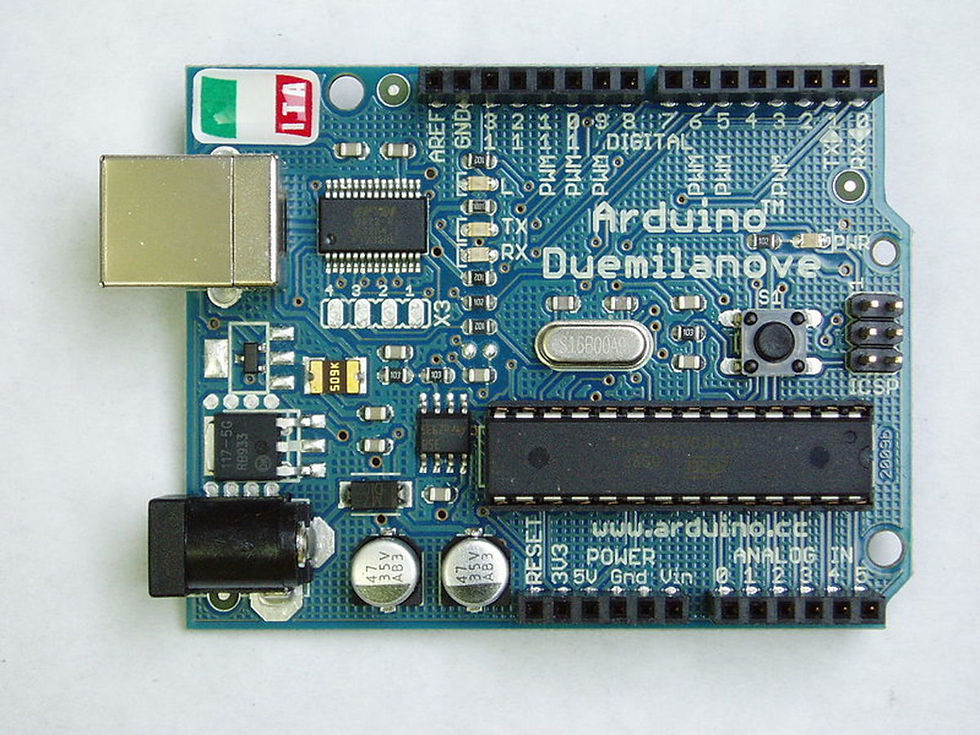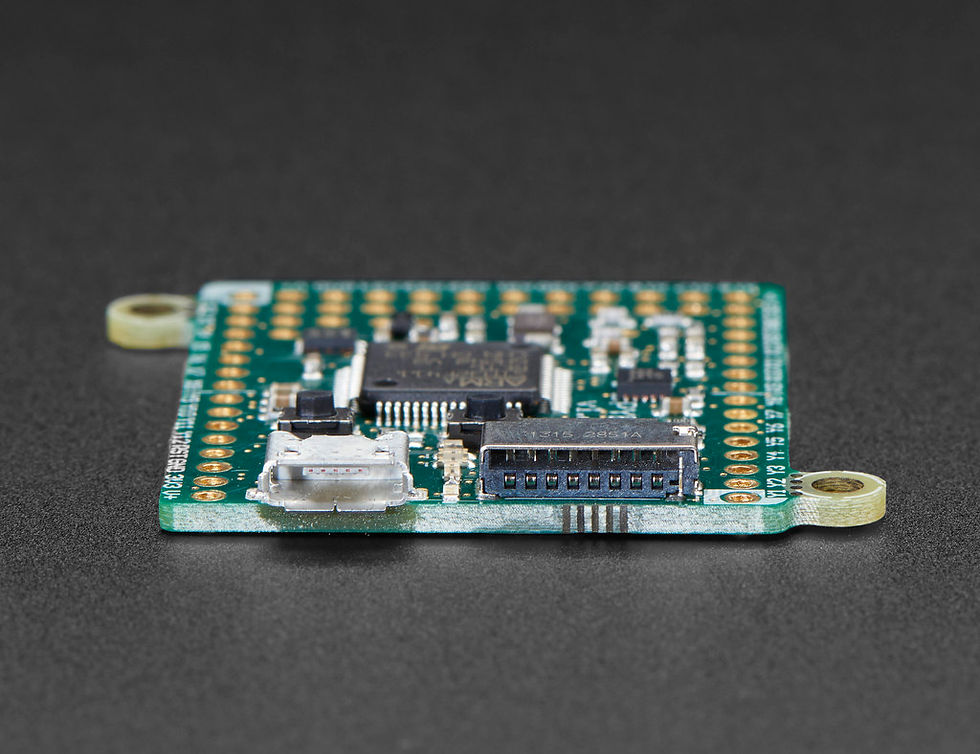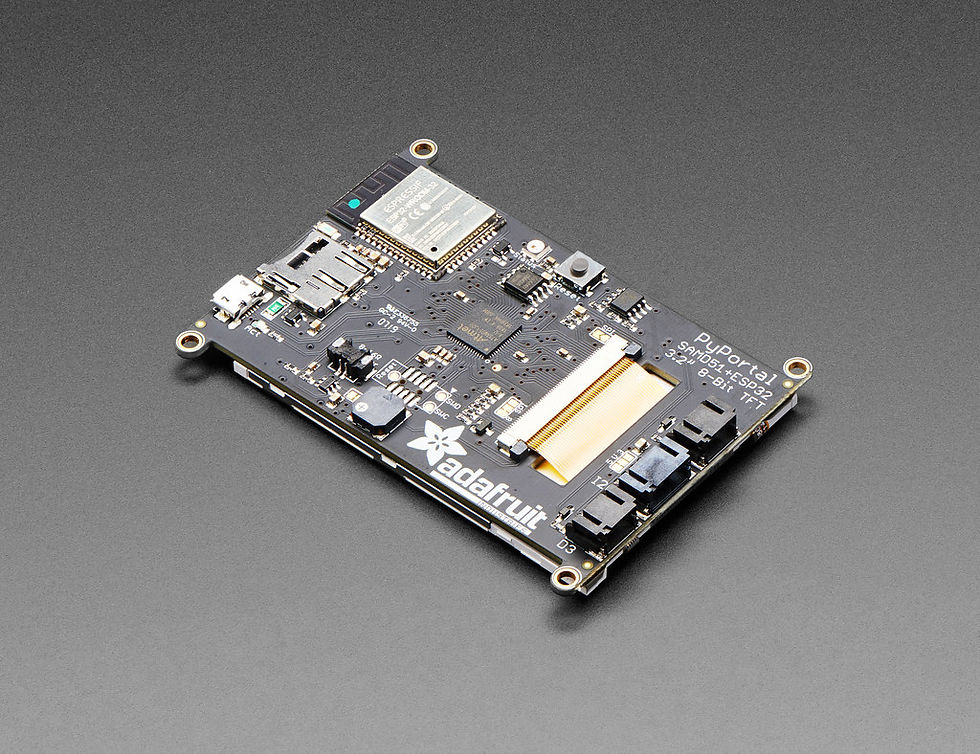An Introduction to Microcontroller Programming with Python
- harshharoraa7
- Sep 20, 2023
- 7 min read
Updated: Sep 15, 2024
Introduction
Microcontrollers are the brains behind a wide range of electronic devices, from simple gadgets to complex systems. While traditional programming languages like C/C++ are commonly used for microcontroller programming, Python has gained popularity for its simplicity and versatility. In this article, we'll embark on an introductory journey into microcontroller programming using Python, exploring its benefits, applications, and how to get started.
Choosing the Right Microcontroller Board
When venturing into microcontroller programming with Python, selecting the appropriate microcontroller board is paramount. Consider factors such as compatibility, available features, and your project's specific requirements. Such As Raspberry Pi, Arduino etc.

Tips for Efficient Microcontroller Programming
Offer practical tips for writing efficient Python code for microcontrollers. This could include optimizing code for resource-constrained environments, handling exceptions, and using sleep modes to conserve power. Such tips can help readers write more effective code for their projects.
The Power of Python for Microcontrollers
Python's rise in microcontroller programming can be attributed to several key factors:
Ease of Learning and Use
Python's syntax is straightforward and human-readable, making it an excellent choice for beginners. Its simplicity allows you to focus on the logic of your program rather than complex syntax.
Rapid Development
Python's high-level nature and rich libraries enable rapid prototyping and development. This is particularly valuable when iterating through ideas or creating proof-of-concept projects.
Versatility
Python's extensive libraries and modules extend its capabilities to various applications, from data analysis and web development to, yes, microcontroller programming.
Community and Resources
The Python community is vast and active, providing access to tutorials, forums, and open-source projects specifically tailored for microcontroller programming.
Getting Started with Microcontroller Programming in Python:
Hardware Selection
Select a microcontroller board that supports Python programming. Boards like MicroPython (compatible with popular microcontroller platforms) and CircuitPython (designed for Adafruit boards) provide Python compatibility out of the box.

Installing the IDE
MicroPython and CircuitPython usually require a specific Integrated Development Environment (IDE). Install the required IDE on your computer to begin writing and uploading Python code to your microcontroller.
Python Libraries for Microcontroller Programming
Discuss the Python libraries and frameworks that make microcontroller programming more accessible. Mention popular libraries like Adafruit CircuitPython, MicroPython, and PySerial. Explain how these libraries simplify hardware interactions and provide essential functions for various projects.

Writing Your First Python Code
Start by writing a simple Python script that interacts with the microcontroller's built-in components. For example, you can blink an LED, read sensor data, or control a servo motor using Python commands.
Uploading Code
Connect your microcontroller board to your computer and upload your Python script to the board. The script will be executed directly on the microcontroller, allowing you to see the results of your code in action.
Troubleshooting Common Microcontroller Issues
Address common challenges that developers might face when programming microcontrollers with Python. Discuss issues like connectivity problems, firmware updates, and debugging techniques. Offering solutions to these problems can be valuable for your readers.
Real-World Applications of Python in Microcontroller Programming
Certainly, here are some real-world examples and case studies showcasing successful applications of Python in microcontroller projects across various domains:
1. Internet of Things (IoT) Applications:
Smart Agriculture: Python has been used to develop IoT solutions for agriculture. Farmers can monitor soil moisture, temperature, and humidity using Python-programmed microcontrollers, enabling efficient irrigation and crop management.
Smart Home Systems: Python-powered microcontrollers play a crucial role in creating smart home ecosystems. They control lighting, heating, security cameras, and more. For instance, a Raspberry Pi running Python can manage home automation tasks seamlessly.
2. Home Automation:
Voice-Activated Home Automation: Python, when integrated with voice recognition libraries, enables voice-controlled home automation systems. Users can use voice commands to control lights, appliances, and thermostats in their homes.
Security Systems: Python can be employed in security systems that use microcontrollers. These systems can detect intrusions, send alerts, and even capture images or videos when motion is detected.
3. Wearable Devices:
Health and Fitness Wearables: Python can be used to develop wearable devices that track health metrics such as heart rate, steps taken, and sleep patterns. These devices sync data with smartphones, providing users with valuable insights into their health.
Gesture-Controlled Wearables: Python, in combination with sensors and microcontrollers, enables the creation of gesture-controlled wearable devices. These devices can be used for hands-free control of gadgets, making them ideal for applications like virtual reality (VR).
4. Robotics:
Educational Robots: Python is widely used in educational robots designed to teach programming and robotics concepts to students. These robots, like the Raspberry Pi-powered robots, enable beginners to learn coding and robotics in a fun and interactive way.
Industrial Automation: Python is applied in industrial robots and automation systems for tasks such as precision manufacturing and material handling. Its versatility allows for easy integration with existing systems.
5. Environmental Monitoring:
Air Quality Monitoring: Python-powered microcontrollers can be used to create air quality monitoring systems. These devices measure pollutants and provide real-time data, contributing to environmental awareness and public health.
Weather Stations: Python can be employed to build DIY weather stations that collect data on temperature, humidity, wind speed, and more. These stations can be used for personal weather tracking or as educational tools.
The Future of Python in Microcontroller Development
The future of Python in microcontroller development holds exciting possibilities and trends that are worth exploring. As technology continues to advance, Python's role in this field is evolving in several key ways:
Increased Adoption: Python's popularity in microcontroller programming is expected to grow further. As more developers become proficient in Python, its use in microcontroller projects will become even more widespread.
Improved Performance: Efforts are underway to optimize Python for microcontrollers. These optimizations aim to reduce memory usage and enhance execution speed, making Python more efficient for resource-constrained environments.
Machine Learning and AI: Python's rich ecosystem of machine learning and artificial intelligence (AI) libraries will continue to impact microcontroller development. As microcontrollers become more powerful, they can handle basic AI tasks, enabling applications like gesture recognition and voice control in IoT devices
Edge Computing: Python's versatility makes it suitable for edge computing applications. Microcontrollers equipped with Python can process data locally, reducing latency and reliance on cloud services. This trend is crucial for applications like real-time sensor data analysis.
IoT Growth: With the proliferation of IoT devices, Python will play a pivotal role in simplifying the development of IoT solutions. Python's ease of use and extensive libraries will continue to attract IoT developers.
Education and Learning: Python's accessibility makes it an ideal choice for teaching programming and electronics. Python-based microcontroller platforms like Raspberry Pi will remain popular in educational settings, nurturing the next generation of innovators.
Integration with Cloud Services: Python's compatibility with cloud services and APIs will enable seamless integration between microcontrollers and cloud platforms, facilitating remote control, data storage, and analysis.
Security and Safety: Python's focus on code readability can enhance security and safety in microcontroller programming. Developers can write more secure code and implement safety-critical applications with confidence.
Community Collaboration: Python's open-source nature ensures active community involvement. Collaborative efforts will lead to the development of new libraries, frameworks, and tools tailored specifically for microcontroller projects.
Interoperability: Python's interoperability with other languages and platforms will continue to be an asset. This allows developers to combine Python with languages like C/C++ when necessary, offering flexibility in microcontroller projects.
Microcontroller Programming Projects with Python
LED Blinking
The "Hello World" of microcontroller programming, this project involves blinking an LED at a specified interval using Python commands.
Temperature and Humidity Sensing
Read data from a temperature and humidity sensor and display the results on an LCD screen or transmit them wirelessly to a computer.
Motor Control
Use Python to control a motor's speed and direction, opening doors to robotics and automation projects.
Interactive Displays
Create interactive displays using touchscreens and Python, enabling users to interact with your microcontroller-based projects.
Check the Project Working video here - Creating a Digital Thermometer using 8051 Microcontroller || 8051 Projects || Proteus Projects
Conclusion
Microcontroller programming with Python introduces a new dimension to the world of embedded systems and electronics. Its user-friendly syntax and rapid development capabilities empower both beginners and experienced programmers to create innovative and interactive projects.
As you embark on your journey into microcontroller programming with Python, remember that every line of code you write brings you closer to unlocking the full potential of your microcontroller board. From LED blinking to complex interactive displays, Python's versatility ensures that your projects are limited only by your imagination.
So, dive in, experiment, and let Python be your guide as you explore the exciting realm of microcontroller programming and bring your electronic creations to life.
PRODUCTS | LINKS |
ATTINY85 8-bit AVR Microcontroller | |
ATmega32A Microcontroller |
See more :
Order Electronics Projects
Want us to guide you through your project or make the project for you? Click on the button below or reach out to us via Call/WhatsApp at (+91) - 7600948607
You can -
Order Basic Electronics Projects
Order Embedded Systems Projects
Order IoT Projects
Order FPGA Projects
Order VLSI Projects
Order Image Processing Projects
Order Matlab Projects
Order TinkerCAD Projects
Order Proteus Projects
Click on the button below to fill out the project inquiry form -
Create Various Projects
Check out our Free Arduino Projects Playlist - Arduino Projects
Check out our Free Raspberry Pi Projects Playlist - Raspberry Pi Projects
Check out our Free TinkerCAD Projects Playlist - TinkerCAD Projects
Check out our Free IoT Projects Playlist - IoT Projects
Check out our Free Home Automation Projects Playlist - Home Automation Projects
Check out our Free NodeMCu Projects Playlist - NodeMCu Projects
Follow us -
Please do follow us i.e. #learnelectronicsindia to get daily updates about new blogs, videos, courses, products, offers, competitions, quizzes, and Internship Opportunities.






Comments